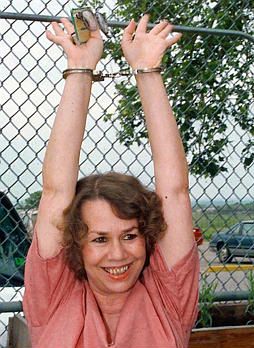LOS FRESNOS, Texas (AP) -- Sometime around 2 a.m. on Sept. 16,
1987, Susan Mowbray was aroused by a noise.
She had stayed up watching Johnny Carson and David Letterman;
her husband, Bill, had moved to her accustomed side of the bed, so she
could be closer to the television.
Finally, she went to sleep -- but then the noise awakened
her. She said she saw her husband's elbow in the air, reached out
to touch him and heard an explosion.
``I knew there was a gun,'' she would tell sheriff's deputies
later that night. ``I groped and grabbed the gun. ... I had been living
with this fear for three years.''
In the darkness, she said, she walked around to her husband's
side of the bed and knelt down. Blood seeped from his head onto the
pillow and sheets. She placed the gun in the pool of blood, went
downstairs and called Luke Fruia, the manager of her husband's Cadillac
dealership.
``Luke, he did it,'' she cried. ``He shot himself.''
------
Eight months later, Susie Mowbray was convicted of shooting her
husband as he slept. The motive? To collect $1.8 million in insurance money.
She was sentenced to life in prison.
In May, after nine years in prison, she was set free. An appeals
court granted her a new trial, ruling prosecutors suppressed blood evidence
that contradicted their murder scenario.
But her freedom may be temporary.
On Jan. 12, after her first Christmas outside prison since 1987,
the 49-year-old Mrs. Mowbray is scheduled to be tried once again in the
slaying of her husband.
``I have to trust that at some point, everyone will see that this
was a horrible family tragedy and a horrible mistake was made,'' she said.
``It's time for us to put this behind us and everyone go on with their
lives. It's been 10 years. That's enough.''
But Bill Mowbray's family and prosecutors want to prove once and
for all that Mrs. Mowbray is a cold-blooded murderer.
``She belongs in jail, and she belongs there for the rest of her
life,'' said Kristin Mowbray, Bill Mowbray's daughter from another marriage.
Mrs. Mowbray's new attorneys plan to focus their case on blood
evidence that prosecutors withheld the first time around. Their star witness
will be blood-spatter expert Herbert MacDonell.
MacDonell was hired by prosecutors prior to the first trial to
examine Mrs. Mowbray's nightgown. He told them he found no blood and that
it was ``very unlikely'' the garment was near the wound at the time of
the shooting ``or it was protected from spatter.''
But MacDonell never testified. Instead, the state hired another
expert who testified that microscopic blood-spatter was found on the gown.
At a 1995 appeals hearing, that expert admitted his testimony was scientifically
invalid because his findings were not confirmed.
After reviewing the crime scene, physical evidence and photographs,
MacDonell has since said Mowbray most likely died from a suicide, not a
homicide.
``The state's problem is Herbert MacDonell,'' said Mrs. Mowbray's
attorney, Robert Ford. ``They hired him. He looked at their evidence and
told them it wasn't any good.''
But those who insist Mrs. Mowbray is guilty say there is plenty of other
evidence to convict her a second time.
``The nightgown has become a smoke screen to somehow convince
people that she's not guilty, but that nightgown to me was never that important
to begin with,'' said Jim Mowbray, Bill Mowbray's brother.
Instead, he points to the testimony of the sheriff's deputies
who first arrived at the Mowbrays' home in Los Fresnos, just west of Brownsville
near the Mexico border.
They testified that Mowbray's right arm -- what would have been
his shooting arm -- was under the covers when they found him and that once
he was moved, they saw no blood on his right hand.
The doctor who performed the autopsy testified it would have been
``impossible'' for Mowbray to shoot himself and not have blood and brain
matter covering his right hand.
George Gavito, a former sheriff's lieutenant who headed the Mowbray
investigation, also noted that a safety lock, installed improperly, was
on the gun when investigators found it. Mowbray, a hunter, would have taken
the lock off before shooting, Gavito insisted.
Lead prosecutor Bill Hagen, who was not involved in the first
trial, is likely to emphasize differences in Mrs. Mowbray's accounts of
the shooting.
In her original statement to authorities, Mrs. Mowbray said her husband
``never said a word'' before killing himself. But in subsequent interviews,
she has said they talked and cried, and that he counted down before shooting
himself.
Ford said he's not concerned about her story. He noted that authorities
failed to take down her entire statement because their tape recorder malfunctioned.
Mrs. Mowbray's supporters, including some of her husband's friends
and associates, maintain Mowbray killed himself. They note he had tried
to commit suicide previously, his car dealership was in financial trouble
and the IRS was after him for tax fraud.
``He told me he would not spend any time in jail, that he would
kill himself before he'd do anything like that,'' said Luke Fruia, who
bought the business after his boss's death.
Others allege evidence supporting Mrs. Mowbray's story has disappeared,
including the T-shirt Mowbray wore the night of the shooting and an electric
blanket.
``I think they (prosecutors) created what they needed to convict
her, or conveniently misplaced evidence that didn't support their theory,''
said Mrs. Mowbray's son, Wade Burnett, who was 16 when his mother was sent
to prison. Now a third-year law student, Burnett has spearheaded the effort
to prove her innocence.
Mrs. Mowbray didn't testify at the first trial, and Ford declined
to say whether she would take the stand this time. If she does, Mrs. Mowbray
said, her message will be simple.
``Bill committed suicide that night,'' she said. ``I was there,
and I did not shoot him. End of statement.''
Back
